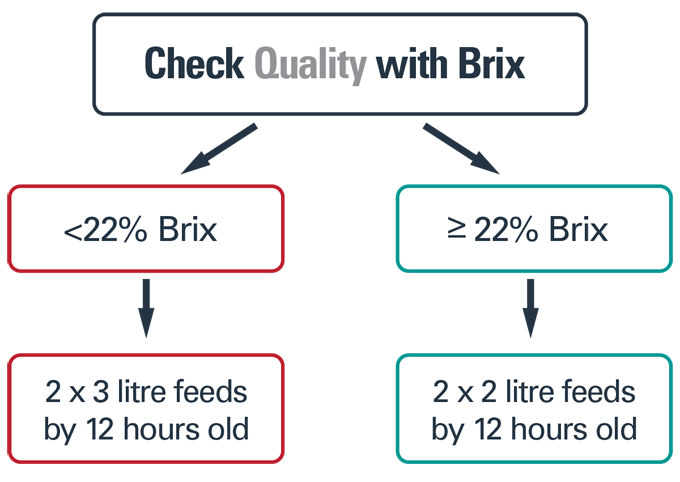COLOSTRUM MANAGEMENT > FACT-SHEET
COLOSTRUM MANAGEMENT AND CALF SCOURS
A calf gets scours when it accidentally eats more scours-causing germs than its immune system can handle. This happens if:
- Its food/environment contains too many scours-causing germs (hygiene) AND/OR
- Its immune system isn’t working as well as it could be (colostrum management)
A new-born calf’s immune system is immature. It needs antibodies from colostrum (the cow’s first milk) to help protect it from getting sick during the first months of life.
COLOSTRUM MANAGEMENT BEST PRACTICES
About a third of calves in New Zealand don’t get enough colostrum as new-borns. To check colostrum management on your farm, ask your vet to blood test 12 healthy 2-7 day old calves.
To improve colostrum management, focus on the “3 Q’s”:
Quickly: feed every calf enough good colostrum by 12 hours of age. A calf’s gut can only absorb antibodies from colostrum into its bloodstream during the first 12 hours of life.
Quantity: feed every new-born calf 10-15% of its body weight (4-6L) of colostrum. About half of calves don’t drink enough colostrum if left on their mother in the paddock for 24 hours without additional feeding.
Quality: colostrum management influences colostrum quality
- feed only clean, fresh, first-milking (“gold”) colostrum to new-borns
- Ideally, this should measure 22% or higher on a Brix refractometer. Feed more colostrum, sooner, if it measures <22% on Brix. (see diagram)
Example Strategy
- Adjust dry cow, springer and colostrum management to improve colostrum quality
- cows vaccinated with Rotavec® Corona make colostrum with more antibodies against rotavirus, coronavirus and E. coli than unvaccinated cows
- cows that are well-fed before calving make better colostrum than poorly-fed animals
- cows milked right after calving give better colostrum than cows milked 12 hours later
REFERENCES
- Berge, ACB et al. (2009). Evaluation of the effects of oral colostrum supplementation during the first fourteen days on the health and performance of pre-weaned calves. Journal of Dairy Science. 92:286–95
- Chuck, G. (2015). Calfwise: right from the start. 2015 Proceedings of the Society of Dairy Cattle Veterinarians of the NZVA Annual Conference. p71-80.
- Chuck, G. (2015). Targeting calf-hood morbidity & mortality. 2015 Proceedings of the Society of Dairy Cattle Veterinarians of he NZVA Annual Conference. p227-232.
- Conneely, M. et al. (2013). Factors associated with the concentration of immunoglobulin G in the colostrum of dairy cows. Animal 7:11. p1824-1832. https://www.cambridge.org/core/journals/animal/
- Cuttance, E. & Denholm, K. (2016). Dairy NZ technical series. Colostrum management: giving calves a great start to life. Accessed online: www.dairynz.co.nz/media/4439069/tech-series-june-2016-colostrum-management.pdf
- Denholm, K et al. (2017). Associations between management practices and colostrum quality on New Zealand dairy farms. New Zealand Veterinary Journal. 65:5. p257-263. DOI: 10.1080/00480169.2017.1342575
- Faber, SN et al. (2005). Case study: effects of colostrum ingestion on lactational performance. The Professional Animal Scientist. 21:420-425.
- Godden, SM et al. (2012). Heat treated colostrum and reduced morbidity in preweaned dairy calves: Results of a randomised trial and examination of mechanisms of effectiveness. Journal of Dairy Science. 95: 4029-4040.
- Gomes, V. et al. (2011). Factors affecting immunoglobulin concentration in colostrum of healthy holstein cows immediately after delivery. Pesq. Vet. Bras. 31:1. http://dx.doi.org/10.1590/S0100-736X2011001300009
- Morrison, S. (2013). The impact of calf health on future performance. Veterinary Ireland Journal. 3:264–8.
- Parkinson, TJ et al. (2010). Calves: management & disease. Diseases of cattle in Australasia: a comprehensive textbook. VetLearn. pp.627-659.
- Recca, A. et al. (2003). Comparative lactogenic antibody responses of cattle from European field trials with a new enteric disease vaccine. Vet Record. 152: 751-752.
- Schouten, B, et al. (2005). Oral electrolytes? A comparative study of some commercial electrolytes. NZVA VetScript.18:6. pp 35-39.
FOR MORE:
Or find us on YouTube by searching: TopFarmersNZ
Or visit: msd-animal-health.co.nz

Top Farmers Know-How provides a reference library of industry best practice in some key animal health management areas including mastitis, dry off, calf health, BVD, salmonella and campylobacter. We know that farmers and vets are busy people, so we’ve created resources in different formats and in bite-sized chunks to make it more flexible and accessible.

